Oregon ants in your lawn can become a problem once the weather turns warmer in the Pacific Northwest. You thought your home was ant-free until a family picnic on your lawn turns into a disaster, or what could have been a happy and memorable outdoor party becomes a painful and unpleasant experience. All thanks to those little brats—Oregon ants.
Ants are tiny, but when in groups or colonies, they can be dangerous to you and your property. If you don’t realize it yet, ants have amazing staying power. They can make your garden or lawn their home and if you don’t exterminate them using effective ant removal options, it’s only a matter of time before Oregon ants build their nests nearby. And there the cycle goes on.
Eliminating ants in your lawn can be tricky as children and pets also access the area often. So how can you get rid of outdoor Oregon ants effectively? Let’s do a background check on these tiny crawlers first.
What type of Oregon ants should you watch out for?
Over 700 different species of ants are found in the United States alone. While most of them are not dangerous to you or your homes and businesses, some Oregon ants are.
Oregon is home to many kinds of ants which can bite, sting, and damage property. There’s a lot of Beaverton ant pest control solutions for your ant problem, with treatments based on different levels of infestation and varying from species to species.
In Oregon, seven types of ants can unexpectedly visit your properties.
1. Odorous Ants/Sugar Ants

Odorous house ants are drawn to sweet stuff—that’s why they’re more commonly known as sugar ants. They emit a rotten coconut scent when crushed and you are likely to find them on your kitchen shelf or in your pantry. They can be seen lurking on sugar bowls, jam jars, candy jars, and other pleasing foods. There is no doubt odorous ants come across as the most common Oregon ants.
Kitchens, bathrooms, and laundry rooms that offer high moisture levels also attract these sugar ants. While they do not impose direct health risks, they can cause food contamination. To avoid these Oregon ants, immediately contact a Beaverton ant pest control company near you.
2. Pavement Ants

The name alone indicates where to search for this Oregon ant type. Pavement ants are also known as concrete ants because you will find them on surfaces and concrete pavements. These black ants are generally not picky about their food.
Pavement ants have long been known to eat insects, seeds, honeydew, bread, meats, nuts, and cheese. They travel along trails up to 30 feet in length and climb walls that enter occupied spaces.
Moist conditions attract pavement ants. They enjoy nesting in piles of wood, so do not store useable wood next to your home or near your fireplace. Prevent these Oregon ants from getting into your home by cleaning up spills and crumbs on countertops and kitchen floors.
3. Argentine Ants

These dark brown Oregon ants originated in Brazil and Argentina, but they are also commonly found in the southeastern part of the country. They emit a stale odor when crushed and measure less than a quarter inch.
Argentine ants are a fan of damp environments, especially when they have found a reliable food source. They eat sweet food, fresh fruits, and budding plants. Infestations of Argentine ants are often accompanied by wide and obvious trails, often climbing up buildings, trees, and into homes.
To get rid of these Oregon ants, keep foods stored in airtight containers and clean up spills immediately. Also, empty birdbaths and grills to remove standing water. Remove trash regularly, and trim tree branches that reach the edges or sections of the house structure. When left untrimmed, these branches serve as highways for Argentine ants to enter your home.
4. Crazy Ants
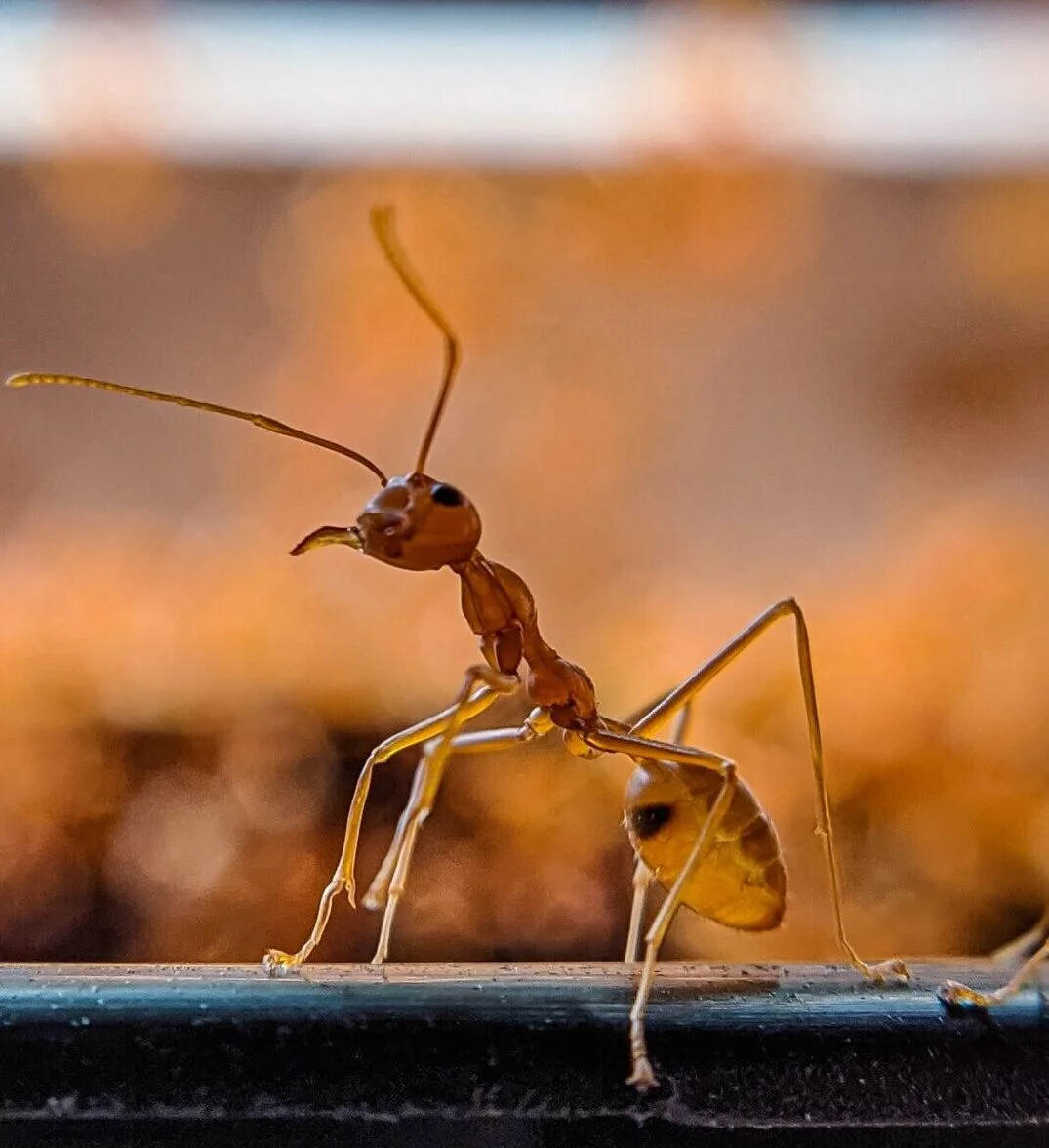
Crazy ants are typically reddish-brown and about an eighth of an inch long. They have tiny hairs on their bodies. This type of ant is described as crazy because they appear to be running all over.
Vast populations of these Oregon ants can drive out other ant species. Although they bite, their bite is less painful than that of fire ants. Crazy ants can become problematic when they spread over a large area of your property. They may also create nests inside your house or electrical equipment, which can result in malfunctions.
A good way to prevent crazy ants is to seal all possible entry points into your house, including small cracks and openings around doors and windows. Keep vegetation away from your home to prevent ant pathways. It is recommended that you clean up food spills and other potential attractants as soon as possible.
5. Thief Ants
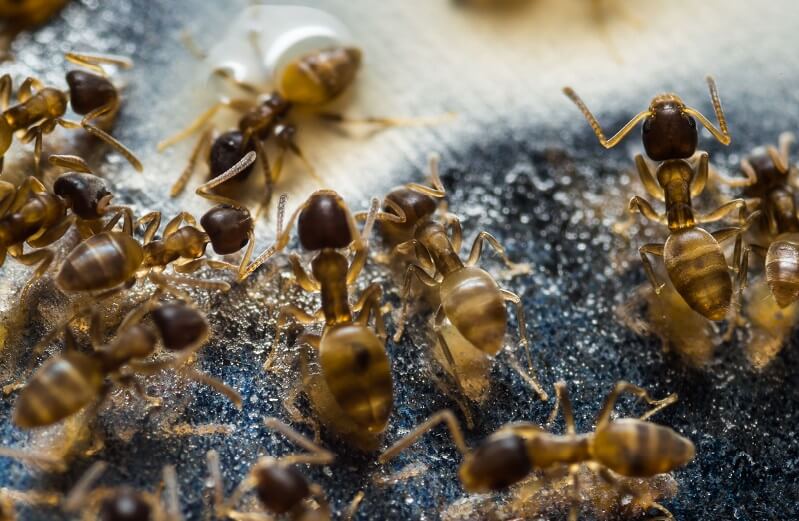
Thief ants, sometimes called “grease ants,” can live anywhere. As their name implies, they build nests adjacent to the nest of another species to steal food from it.
One of the smallest kinds of Oregon ants, thief ants can enter your house through holes in the walls and cracks in woods. When the weather is hot, these pests tend to spend more time inside seeking food and water. They feed on fatty, protein-rich foods and sweets. Due to their ridiculously small size, thief ants can get into practically any packaged foods and can be difficult to control.
To prevent thief ants, all access to food and water sources must be eliminated. Clean up crumbs and fix any utilities. Cracks, crevices, and other access points to your home are a common entry point for Oregon ants, so make sure to seal these up as well.
6. Pharaoh Ants
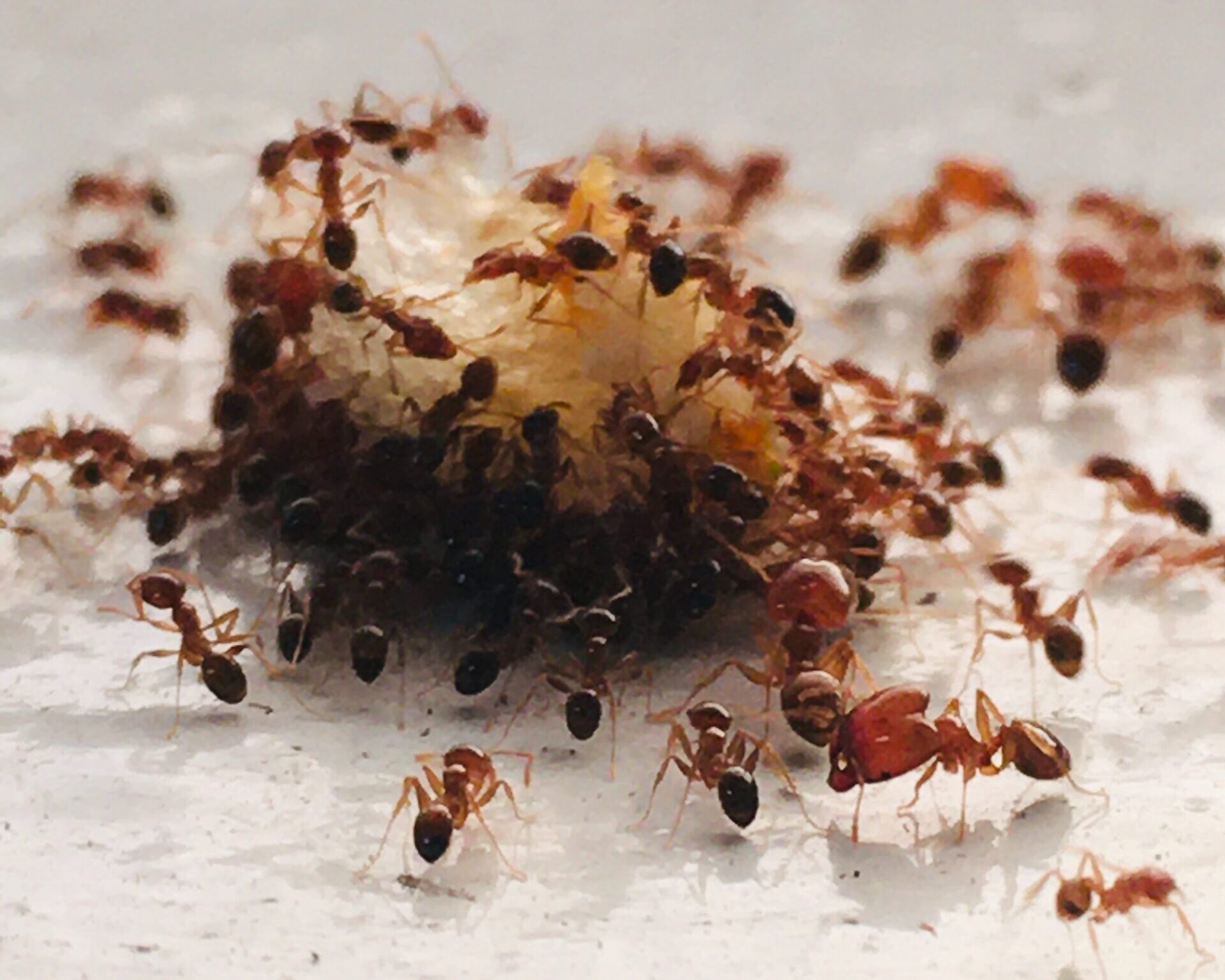
Though these ants were initially thought to be one of Egypt’s famed plagues, they are native to Africa. They possess an attractive color that ranges from yellow to orange.
Pharaoh ants nest in locations that are difficult to visit, such as inside appliances, in pieces of clothing, bedspreads, and towels, walls, tiles, and furniture. They often get inside inaccessible places using telephone and electric wires as a means of moving through walls and over floors.
Pharaoh ants are considered by pest control professionals as one of the toughest types of Oregon ants to get rid of. They can grow rapidly, and when disturbed, they can easily move their colonies to different locations. Pharaoh ants are known to spread diseases. When controlling this type of ant, it is best to seek the help of an ant exterminator. You can book an appointment with ANT & GARDEN ORGANIC PEST CONTROL to resolve this.
7. Harvester Ants

The name ‘harvester ant’ comes from the fact that these Oregon ants get their food from harvesting seeds. They are relatively large, and some variants have long hair that resembles beards.
Harvester ants generally prefer to build their nests on flat lawns, but they will also nest on sandy soil. They are a problem in urban areas because they sting. They also destroy vegetation around their nests, leading to large barren patches in lawns.
You can quickly identify the nest of harvester ants by looking for bare soil. Mounds should be captured during the hottest part of the day, or right before these Oregon ants emerge from the nest. Although harvester ants usually avoid homes, they can enter by accident through cracks and gaps around windows or doors.
You can effectively treat a harvester ant mound using ant baits, but it is best to hire a professional and licensed ant exterminator. Contact ANT & GARDEN ORGANIC PEST CONTROL immediately.
DIY ways to eliminate Oregon ants outdoors
Even though Oregon ants come in different types, they are all attracted to water, grease, sweets, and food crumbs. If they’ve already made your lawn or garden their base, you can follow and use the following ant removal methods to get rid of them.
- Boiling water + liquid soap (optional)
Pour the hot water directly into the nest. - Vinegar + liquid soap
Mix equal parts of liquid soap and vinegar, then rake the nest open and pour the mixture in. Vinegar may kill grass, so use with caution. - Water with a hose
Saturate the soil by watering the nest in the ground for 15 minutes. Oregon ants can remain underwater 24 hours, so you may need to repeat the treatment after 22 to 23 hours. - Water + Boric acid crystals + sugar or peanut butter
Mix two cups of water, three tablespoons sugar or peanut butter, and two tablespoons boric acid crystals and boil for 6 minutes until the crystals are dissolved. Use a yogurt cup to build a bait container. Drill holes in it for Oregon ants to crawl through. Put two to three tablespoons of the ant-baiting solution into the container. Place the container near the ant nest. - Chemical ant killers
Follow the label instructions when applying a pesticide in a liquid, dust, granule, or powder form to the top of the ant mound. These can be toxic to humans, pets, and animals, so be careful when using them. Better yet, call ANT & GARDEN ORGANIC PEST CONTROL in Beaverton for safer, less toxic organic solutions to get rid of Oregon ants.
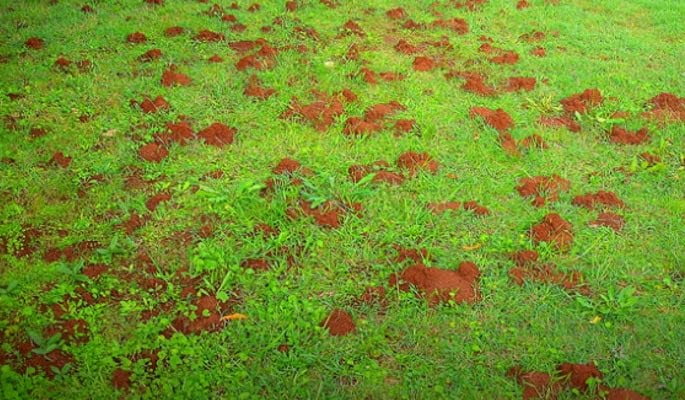
How to Protect Your Home from Oregon Ants
Remember that prevention is the key to make your home ant-free.
- Seal food containers tightly.
- Put recyclable food containers in the sink and rinse them thoroughly before disposal. Empty trash, compost, and recycling containers every day.
- Be on the lookout for plumbing leaks that needs fixing. Be sure to fix leaks as soon as possible—before foraging scout ants discover them.
- Identify and seal entry points to eliminate access points.
- Seal your foundation and exterior walls with caulk.
- Shield your home’s exterior from woodpiles.
- Add a stone barrier of 12 to 18 inches thick between your home’s foundation and any grass.
Seeking Professional Ant Pest Control Services
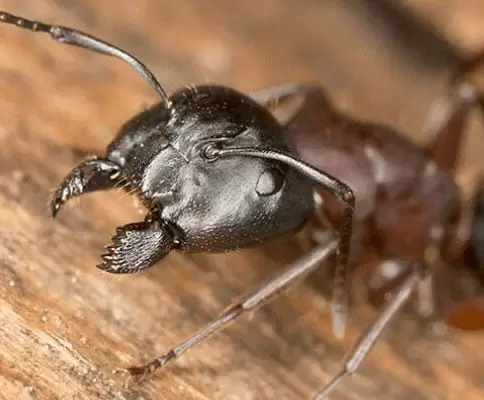
Home remedies may only work to a limited extent. The DIY methods mentioned above will help you to get rid of Oregon ants that are visible.
A truly effective treatment that will ultimately solve your ant problem requires the help of an ant pest expert. Professional ant exterminators are knowledgeable and well-trained. When Oregon ants begin to build mounds in your yard or move inside your cupboard looking for food, they become a pest.
Ant pest control services in Beaverton, OR usually do the following steps:
- Identify ant species present in your lawn and determine an appropriate treatment.
To get the best results, ant exterminators must first determine the type of Oregon ants causing the problem. Once they identified the ant species, the next step is to determine which type of insect treatment best fits the specific case. - Assess the extent of ant infestation.
The ant exterminator will need to gather as much information about its clients to make the best plan. It is important to consider the potential adverse effects of the treatment on humans, pets, and plants. Therefore, careful consideration is necessary to make decisions. - Provide appropriate treatment for Oregon ants.
Since many of the common insecticides are toxic when ingested by people and animals, the exterminator will suggest the most effective but safest way to solve the ant infestation. ANT & GARDEN ORGANIC PEST CONTROL uses only organic substances to eliminate Oregon ants while also protecting your family from toxic chemicals.
Keeping Your Home Free From Oregon Ants
Having an idea of the types of ants common in Oregon will greatly benefit you, especially in maintaining your home. Your home is an investment, and every homeowner would agree that it should be well-maintained.
Though keeping your home free of Oregon ants and other pests can be a daunting task at times, you can now forever keep your worries at bay. When things get out of control, you can always reach out to ANT & GARDEN ORGANIC PEST CONTROL. Do not let these unwanted guests stay longer in your homes! Get a FREE consultation and experience a relaxing, ant-free, and comfortable home you truly deserve.
